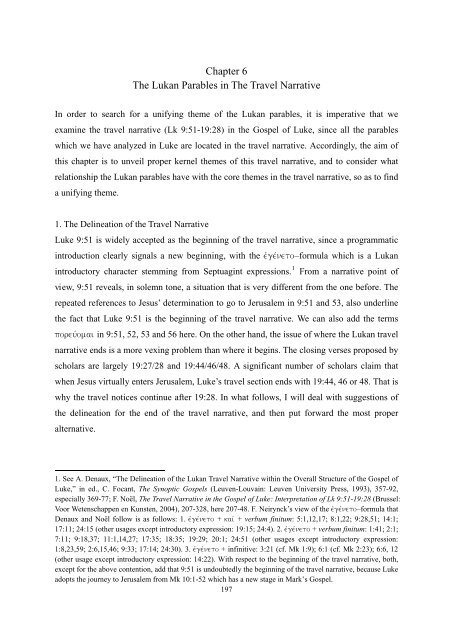the role of the lukan parables in terms of the purpose of luke's gospel
the role of the lukan parables in terms of the purpose of luke's gospel
the role of the lukan parables in terms of the purpose of luke's gospel
Create successful ePaper yourself
Turn your PDF publications into a flip-book with our unique Google optimized e-Paper software.
Chapter 6<br />
The Lukan Parables <strong>in</strong> The Travel Narrative<br />
In order to search for a unify<strong>in</strong>g <strong>the</strong>me <strong>of</strong> <strong>the</strong> Lukan <strong>parables</strong>, it is imperative that we<br />
exam<strong>in</strong>e <strong>the</strong> travel narrative (Lk 9:51-19:28) <strong>in</strong> <strong>the</strong> Gospel <strong>of</strong> Luke, s<strong>in</strong>ce all <strong>the</strong> <strong>parables</strong><br />
which we have analyzed <strong>in</strong> Luke are located <strong>in</strong> <strong>the</strong> travel narrative. Accord<strong>in</strong>gly, <strong>the</strong> aim <strong>of</strong><br />
this chapter is to unveil proper kernel <strong>the</strong>mes <strong>of</strong> this travel narrative, and to consider what<br />
relationship <strong>the</strong> Lukan <strong>parables</strong> have with <strong>the</strong> core <strong>the</strong>mes <strong>in</strong> <strong>the</strong> travel narrative, so as to f<strong>in</strong>d<br />
a unify<strong>in</strong>g <strong>the</strong>me.<br />
1. The Del<strong>in</strong>eation <strong>of</strong> <strong>the</strong> Travel Narrative<br />
Luke 9:51 is widely accepted as <strong>the</strong> beg<strong>in</strong>n<strong>in</strong>g <strong>of</strong> <strong>the</strong> travel narrative, s<strong>in</strong>ce a programmatic<br />
<strong>in</strong>troduction clearly signals a new beg<strong>in</strong>n<strong>in</strong>g, with <strong>the</strong> –formula which is a Lukan<br />
<strong>in</strong>troductory character stemm<strong>in</strong>g from Septuag<strong>in</strong>t expressions. 1<br />
From a narrative po<strong>in</strong>t <strong>of</strong><br />
view, 9:51 reveals, <strong>in</strong> solemn tone, a situation that is very different from <strong>the</strong> one before. The<br />
repeated references to Jesus’ determ<strong>in</strong>ation to go to Jerusalem <strong>in</strong> 9:51 and 53, also underl<strong>in</strong>e<br />
<strong>the</strong> fact that Luke 9:51 is <strong>the</strong> beg<strong>in</strong>n<strong>in</strong>g <strong>of</strong> <strong>the</strong> travel narrative. We can also add <strong>the</strong> <strong>terms</strong><br />
<strong>in</strong> 9:51, 52, 53 and 56 here. On <strong>the</strong> o<strong>the</strong>r hand, <strong>the</strong> issue <strong>of</strong> where <strong>the</strong> Lukan travel<br />
narrative ends is a more vex<strong>in</strong>g problem than where it beg<strong>in</strong>s. The clos<strong>in</strong>g verses proposed by<br />
scholars are largely 19:27/28 and 19:44/46/48. A significant number <strong>of</strong> scholars claim that<br />
when Jesus virtually enters Jerusalem, Luke’s travel section ends with 19:44, 46 or 48. That is<br />
why <strong>the</strong> travel notices cont<strong>in</strong>ue after 19:28. In what follows, I will deal with suggestions <strong>of</strong><br />
<strong>the</strong> del<strong>in</strong>eation for <strong>the</strong> end <strong>of</strong> <strong>the</strong> travel narrative, and <strong>the</strong>n put forward <strong>the</strong> most proper<br />
alternative.<br />
1. See A. Denaux, “The Del<strong>in</strong>eation <strong>of</strong> <strong>the</strong> Lukan Travel Narrative with<strong>in</strong> <strong>the</strong> Overall Structure <strong>of</strong> <strong>the</strong> Gospel <strong>of</strong><br />
Luke,” <strong>in</strong> ed., C. Focant, The Synoptic Gospels (Leuven-Louva<strong>in</strong>: Leuven University Press, 1993), 357-92,<br />
especially 369-77; F. Noël, The Travel Narrative <strong>in</strong> <strong>the</strong> Gospel <strong>of</strong> Luke: Interpretation <strong>of</strong> Lk 9:51-19:28 (Brussel:<br />
Voor Wetenschappen en Kunsten, 2004), 207-328, here 207-48. F. Neirynck’s view <strong>of</strong> <strong>the</strong> –formula that<br />
Denaux and Noël follow is as follows: 1. + + verbum f<strong>in</strong>itum: 5:1,12,17; 8:1,22; 9:28,51; 14:1;<br />
17:11; 24:15 (o<strong>the</strong>r usages except <strong>in</strong>troductory expression: 19:15; 24:4). 2. + verbum f<strong>in</strong>itum: 1:41; 2:1;<br />
7:11; 9:18,37; 11:1,14,27; 17:35; 18:35; 19:29; 20:1; 24:51 (o<strong>the</strong>r usages except <strong>in</strong>troductory expression:<br />
1:8,23,59; 2:6,15,46; 9:33; 17:14; 24:30). 3. + <strong>in</strong>f<strong>in</strong>itive: 3:21 (cf. Mk 1:9); 6:1 (cf. Mk 2:23); 6:6, 12<br />
(o<strong>the</strong>r usage except <strong>in</strong>troductory expression: 14:22). With respect to <strong>the</strong> beg<strong>in</strong>n<strong>in</strong>g <strong>of</strong> <strong>the</strong> travel narrative, both,<br />
except for <strong>the</strong> above contention, add that 9:51 is undoubtedly <strong>the</strong> beg<strong>in</strong>n<strong>in</strong>g <strong>of</strong> <strong>the</strong> travel narrative, because Luke<br />
adopts <strong>the</strong> journey to Jerusalem from Mk 10:1-52 which has a new stage <strong>in</strong> Mark’s Gospel.<br />
197
















